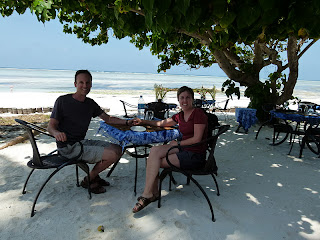At the end of our safaris, we were really tired and ready for some downtime in Zanzibar. Zanzibar is an island off the coast of Tanzania and it's a popular post-safari stopping point with lots of sun and beautiful beaches.
Here are a few photos from our resort.
We spent a day touring and learned lots about Zanzibar. The island has nice weather and beaches but we learned that there's more to Zanzibar than just fun and sun.
Our first stop was Stone Town which is the old town part of Zanzibar. It's a maze of narrow alleys.
The busiest part of Stone Town is the market. The market is open every day of the year and you can get anything you need - an open air, east Africa version of a Wal-Mart Supercenter.
On a happier note, Zanzibar was a centre for the spice trade and the region is known as the Spice Islands. The island has soil and climate that make it a great place to grow all kinds of spices including cloves, cinnamon, nutmeg and vanilla. Most spice production has moved off the island but there are spice farms across the island where you can see how things are grown and how they're used.
On our last night in Zanzibar, there was a band playing at the resort and they finished their set with "Hold On To The Night" by Richard Marx - a song from the 80s that everyone our age (and almost everyone else) will know very well. We danced by the pool under the stars and it was the perfect song for the moment. It was one of the best times of our trip.
Vanessa and Blake
Here are a few photos from our resort.
 |
| View of our resort from the water |
 |
| White sand beaches that go forever |
 |
| Exploring the reef at low tide - very warm water |
 |
| Lunch on the beach |
 |
| Staying in the shade - the UV index was 11+ (extreme) |
 |
| More relaxing |
 |
| Nice dinners |
We spent a day touring and learned lots about Zanzibar. The island has nice weather and beaches but we learned that there's more to Zanzibar than just fun and sun.
Our first stop was Stone Town which is the old town part of Zanzibar. It's a maze of narrow alleys.
 |
| View from the ground |
 |
| View from up higher |
 |
| Lots of cute cats |
 |
| Nice beaches too |
The busiest part of Stone Town is the market. The market is open every day of the year and you can get anything you need - an open air, east Africa version of a Wal-Mart Supercenter.
 |
| The fish portion of the market |
 |
| Commercial fishermen auction the catch of the day |
 |
| Octopus and squid |
 |
| Every type of fruit you can imagine |
 |
| Chicken - either living or not |
 |
| More of the bustling market |
Here are a few views of Zanzibar outside of Stone Town.
Zanzibar has an interesting past - it used to be one of the primary trading centres in east Africa. The two major commodities were slaves and spices.
 |
| View from the backseat |
 |
| As many bikes as cars on the road |
 |
| Lots of fruit stands |
 |
| Clothes for sale too |
Zanzibar has an interesting past - it used to be one of the primary trading centres in east Africa. The two major commodities were slaves and spices.
In the mid-19th century, 50,000 slaves from across east Africa passed through Zanzibar each year. Slaves were captured on the African mainland, marched over long distances to the Tanzanian coast and then shipped by small boats to Zanzibar. Those that survived were crammed into underground holding cells with no sanitation, little food and concrete slabs to sleep on. They were then put up for auction and sent to the Middle East, India and southeast Asia.
 |
| Underground room used to hold slaves before auction |
 |
| Monument showing how slaves were auctioned |
On a happier note, Zanzibar was a centre for the spice trade and the region is known as the Spice Islands. The island has soil and climate that make it a great place to grow all kinds of spices including cloves, cinnamon, nutmeg and vanilla. Most spice production has moved off the island but there are spice farms across the island where you can see how things are grown and how they're used.
 |
| Lipstick fruit used for ... |
 |
| Jackfruit that's commonly eaten in India and southeast Asia |
 |
| One of our guides climbing a coconut tree |
 |
| He went to the top of this tree (over 100 feet) - singing all the way up |
 |
| Very cute kids |
On our last night in Zanzibar, there was a band playing at the resort and they finished their set with "Hold On To The Night" by Richard Marx - a song from the 80s that everyone our age (and almost everyone else) will know very well. We danced by the pool under the stars and it was the perfect song for the moment. It was one of the best times of our trip.
Vanessa and Blake
























